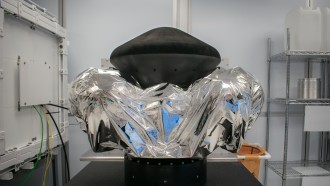So you want to get an Android phablet from Huawei? We are here to help you compare and contrast the specs of the Nexus 6P and Mate 8.
Both of Huawei's phablets are packed with excellent features and powerful specs, but it's inevitable that one is better than the other in some aspect or another.
Design And Materials
The Mate 8 is the latest release from Huawei, and the company described it as its "most advanced flagship smartphone." The gadget has a sleek, futuristic design that uses a premium metallic chassis. Huawei says that the build is based on aerospace-grade aluminum as well as 2.5D curved diamond-cut glass. The Mate 8 chromatic options are Moonlight Silver, Champagne Gold, Mocha Brown and Space Gray.
The Nexus 6P was launched in September and its design, although based on the general lines of previous Nexus devices, got an upgrade. The 6P is the first metallic Nexus; its uni-body is made of anodized aluminum while its screen is made of 3D curved glass. Diamond chamfers frame the elite look of the Nexus 6P, whose color options are Frost, Graphite and Aluminum.
The Nexus 6P weighs 178 grams (6.28 ounces) and measures 159.3 x 77.8 x 7.3 millimeters (6.27 x 3.06 x 0.29 inches), while the Mate 8 is a tad heavier at 185 grams (6.53 ounces) and has dimensions of 157.1 x 80.6 x 7.9 millimeters (6.19 x 3.17 x 0.31 inches).
CPU And GPU
The Mate 8 works on an eight-core CPU, the Kirin 950 SoC, which is backed by a Mali T880MP4 graphic processing unit. Details about the SoC show that the Kirin 950 contains four Cortex-A72 cores buzzing at 2.3GHz and another four Cortex-A53 ones, running at 1.8GHz. The manufacturer showcased the performance of the Kirin 950 on AnTuTu, where it scored an impressive 83,000 points on a demo rig. However, it remains to be seen how it works on an actual end device. An i5 coprocessor is incorporated, and it useful at assisting low-power processes. Huawei pointed out that the secondary SoC was crafted using TSMC's 16nm FinFET process.
Nexus 6P's chipset is a Qualcomm Snapdragon 810, and an in-depth look reveals that four Cortex-A53 cores run at 1.55GHz and the other four Cortex-A57 cores at 2.0GHz. The graphics of the Nexus 6P rely on the Adreno 430 GPU.
Display, Camera And Features
The Mate 8 sports a 6-inch IPS-NEO LCD capacitive touchscreen display, capable of a resolution of 1,080 x 1,920 pixels. Gorilla Glass 4 gives the screen resistance to scratches and bumps.
The extra-large handset borrows the recent Sony IMX298 16MP sensor for the main camera, while also featuring an 8MP selfie snapper on the front side. Under the main camera, the Mate 8 has a fingerprint sensor.
The Nexus 6P sports a capacitive touchscreen of 5.7 inches, able to display at 1,440 x 2,560 pixel resolution. The multi-touch screen is made of Gorilla Glass 4 with oleophobic coating. The camera combo on the Nexus 6P consists of a main snapper of 12.3MP with laser autofocus, dual-LED flash and an 8MP selfie snapper. Underneath the main camera sits a fingerprint sensor, as well.
Features such as touch focus, geotagging, panorama, HDR and face detection are available for both phablets.
The Nexus 6P battery is powerful at 3,450mAh, yet is slightly smaller than the Mate 8's, which carries a massive 4,000mAh unit.
RAM, Storage Space And Price
A few combos of RAM and storage are available for the Mate 8. One is 3GB of RAM with 32GB storage space, another is 4GB RAM with 64GB storage space, and the last is 4GB of RAM with a hefty 128GB of storage space.
Their respective prices roam around $480, $590 and $700, respectively.
The Nexus 6P also comes in three variants, all equipped with 3GB of RAM. Load capacity is variable for the different models, with 32/64/128 GB of storage space.
U.S. pricing for the three 6P variants are $499, $549 and $649.
Whereas the Nexus 6P has no memory extension capacity, the Mate 8 supports up to 128GB of extra storage space via the SIM 2 slot that can accommodate a microSD card.
Network And Connectivity
The Nexus 6P works on GSM, CDMA, LTE and HSPA networks, while the Mate 8 lacks the CDMA option.
Both devices have Wi-Fi 802.11 a/b/g/n/ac, Bluetooth, GPS, NFC and USB 2.0, but only the Mate 8 will let you listen to FM radio. On the other hand, the Nexus 6P offers a Type-C 1.0 USB reversible connector, which is rumored to be the next big thing.
Operating System
Huawei's next-generation EMUI 4.0 OS, which is built on Android 6.0 Marshmallow, comes embedded into the Mate 8. Features include a power-saving firewall, a defragmenter, eRecovery and voice controls.
The Nexus 6P also comes with Android 6.0 Marshmallow preinstalled and Google Now is there to help you find what you need easily.
Conclusion
The two Huawei phablets both have strong points, and it is up to users to decide what tilts the balance. It could be screen size, storage capacity, the user interface or the camera combo. Regardless of the choice, Huawei comes with strong offerings that can compete with most rival devices on the market today.
It's important to note that for now, the Mate 8 will be made available only in China, where it will go on sale in Q1 2016. The CES edition, scheduled for January 2016, should reveal the international launch date.








